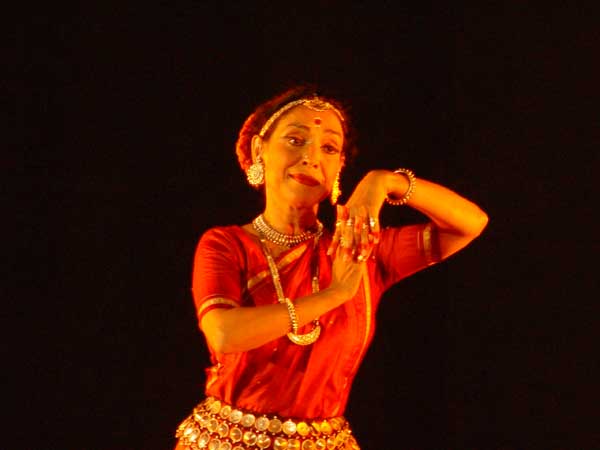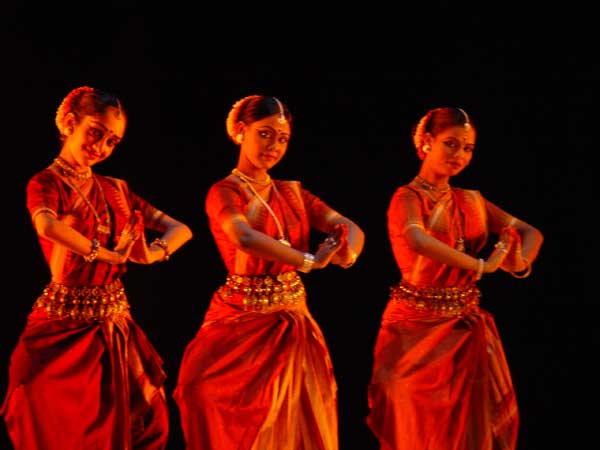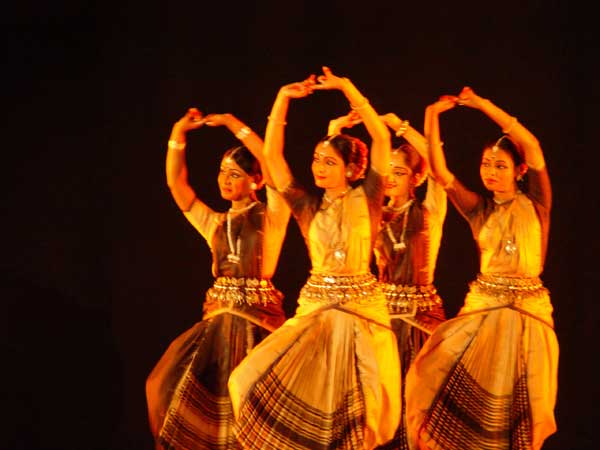Contribute
| Madhavi Mudgal Performs Odissi At National Heritage Museum |
Pallavi Nagesha
09/22/2005
Dressed in traditional Orissa handloom costumes and, silver filigree jewelry and the symbolic temple head piece Madhavi and her four disciples swept the audience away into divine rapture. The evening’s repertoire began with the Ganga Stavan, an invocation. As Madhavi lithely moved to wonderful poetry, her disciples, Moumita Ghosh, Arushi Mudgal and Sudha Malik depicted River Ganga’s descent from Lord Shiva’s tresses in the background. This lovely presentation evoked images of Temple dances in India, with the Temple architecture as a backdrop. I cannot think of a more perfect Mangalacharan than a salutation to river Ganga. Not only does Ganga symbolize purity and bounty, Odissi, with its sensuous movements, sculpturesque stance, and deep seated spiritual context evokes images of the majestic river meandering gracefully and symbolizing everything that is pure and holy. This was followed by the Dvidha, a playful yet elusive exploration of time and space in a duet. The two dancers, as tangible forms merge and swerve to create, and carry to a crescendo visual patterns set to the raga and tala. Madhavi’s schooling in architecture was subtly apparent in this abstract interpretation of concrete forms born from the synergy of time and space. Then came the evening’s mainstay, Vasant, a solo by Madhavi Mudgal. Then Madhavi’s genius as a teacher comes through in the presentation of the Arabhi Pallavi by her four disciples (Moumita Ghosh, Arushi Mudgal, Sudha Mallik, and Diya Sen). The Pallavi is a pure Nritta piece where the dancers gracefully move to the music using elaborate hand gestures and statue like stances. The dancers’ strength and elegance transudes through in this piece, as well as the next item, Kalyan, which celebrates the omnipresence of the Life Force. Finally an exhibition of Madhavi’s impeccable choreography in the Pallavan, a dance seeking deliverance. This end piece choreographed by Madhavi as a modern extension of the classical was spirited, and energetic. The ripple effect choreographed into this piece was delectable. The dance seemed to melt out of a quiescent picture. Then, as the dance evolves and comes to completion, the dancers congeal back into the statues they evanesced from. The fundamental movement in Odissi which is spiral (rather than liner as in Bharatanatyam) is reproduced here visually. This piece, like all others, was choreographed such that the music was intricately woven into the Nritya. The grace, the energy, synchrony and the sheer beauty of the performance has left me wanting more. Going in to the concert, I, like quite a few audiences, knew little or nothing about Odissi. After the performance, I spoke with Madhavi Mudgal to learn something about the dance form as well as her role is disseminating it the world over. Odissi traces back to the golden rule of King Kharavela (2nd century BC) and to the dance sculptures gilding the temple walls. Lost to the world as the Devadasi tradition ebbed, this dance form was revived and reconstructed by great artists in the mid 20th century. One of them was Guru Kelucharan Mahapatra, Madhavi Mudgal’s guruji. The form of Odissi we see today is restructured from fragments of the Mahari tradition, the Gotipua tradition, the Natyashastra and from the inspiration drawn from the temple sculptures. Odissi’s “lyrical quality†and “gracefull subtlety†is what lured Madhavi to it, away from Kathak and Bharatanatyam, which she also learned. This dance form has a quality of merging from one thing to the next without pause that gives it the spiral trait that we saw in the performance, especially the Pallavan. Dance to Madhavi is “an extension of feelings gathered†over time. Being the daughter of a prominent musician (Vinay Chandra Maudgalya) her profound understanding of music and her training as an architect “enlarged her canvas†and helped her put into perspective her imagination thus making her a perceptive and powerful choreographer and an ingenious teacher. Much like her own gurus and other true gurus in India, she imparts life skills where you are enabled, taught to think and question and search. Where instruction is not just handed to you, but it envelops you and the guru guides you to find your own way through the fog and absorb as much as you can on the way. This is why, Madhavi agrees, it takes you “years to master any art.†The emphasis is on the process, not the product. And time is one thing we 21st century people don’t have. It will take far more dedication and energy to keep such wondrous traditions alive and the efforts of teachers like Madhavi are to be commended.
“…sukhaa pradoSaaH divasaaH ca ramyaaH sarvam priye caaru taram vasante ||â€
This rendition of a part of Kalidasa’s Ritusamharam did, indeed herald feelings springtide verve. Both her Nritta and Abhinaya exhibited here is spine-tingling. This piece brought forth Madhavi’s command over Odissi as she flirts with the powerful words and the intense music while depicting the beauty and profusion of spring.
You may also access this article through our web-site http://www.lokvani.com/


